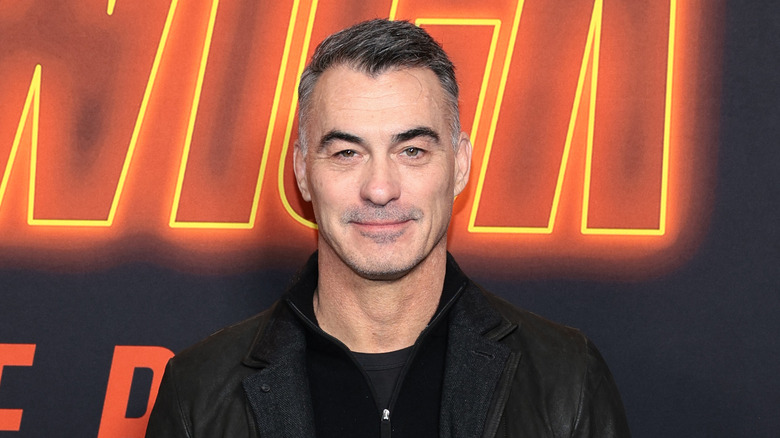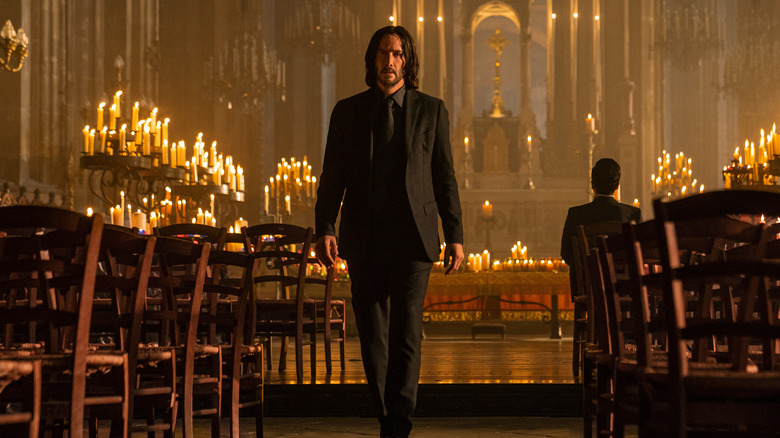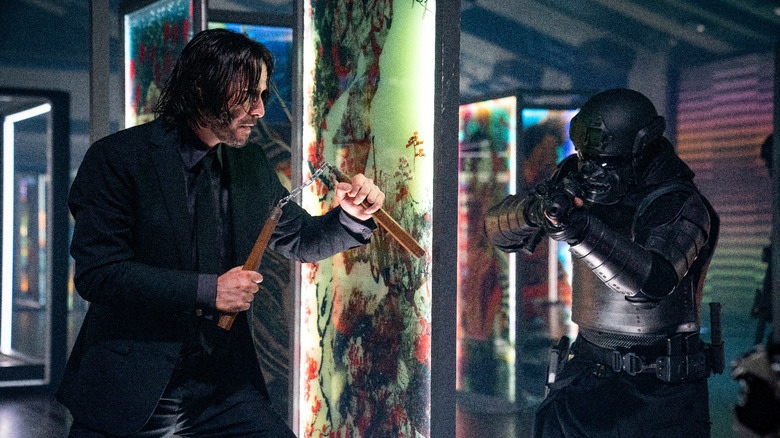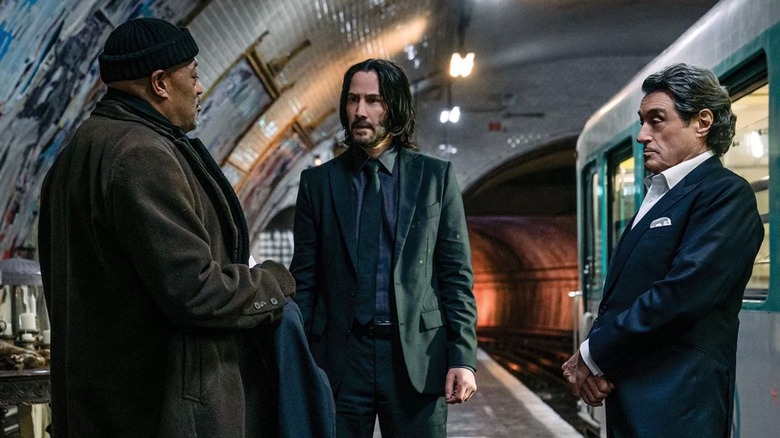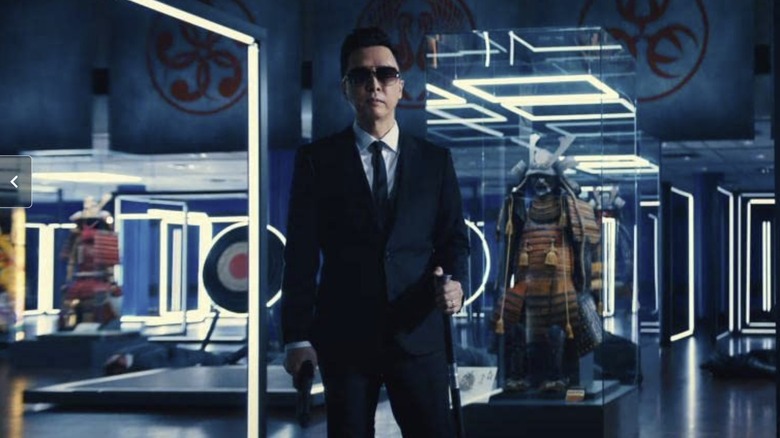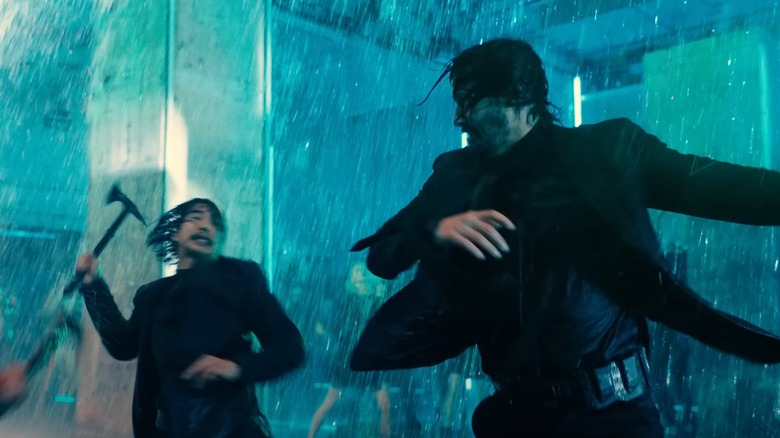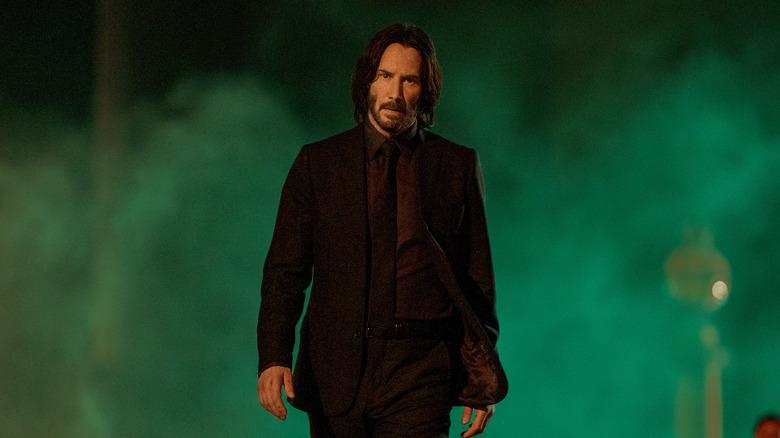John Wick 4 Director Chad Stahelski Talks The Franchise's Past, Future, And More - Exclusive Interview
Along with star Keanu Reeves and original writer Derek Kolstad, director Chad Stahelski is one of the architects of the ever-evolving "John Wick" universe. Working for years as a stuntperson, stunt coordinator, and second-unit director on films ranging from "The Matrix" to "Captain America: Civil War," Stahelski made the jump to the big chair when he and fellow stunt coordinator (and business partner) David Leitch co-directed the first "John Wick" in 2014.
Produced independently, the movie combined elements of neo-noir, Hong Kong cinema, and mainstream crime dramas with highly stylized visuals and action sequences to create a surreal, unique thriller unlike anything else released at the time. It became a sleeper hit at the box office, a favorite with critics and fans, and led to a slew of sequels, including the epic new "John Wick: Chapter 4."
In the film, Reeves' title assassin makes one final, all-out attempt to escape the clutches of the crime organization known as the High Table. Along with Reeves and returning actors Ian McShane, Laurence Fishburne, and the late Lance Reddick, the cast includes screen legends and martial artists Donnie Yen, Hiroyuki Sanada, and Scott Adkins. Delving even further into John's strange world, Stahelski and company stage more than a dozen dazzling action scenes, including a massive fight amidst an onslaught of speeding cars at Paris' Arc de Triomphe and a neon-soaked showdown at the Osaka Continental.
In addition to helming all three "John Wick" sequels, Stahelski is also an executive producer on the upcoming spin-off series "The Continental" and "Wick"-adjacent movie "Ballerina." Yet even though the "Wick" cinematic universe is expanding, Stahelski told us in our exclusive interview that there's no master plan behind it all. "We didn't come from a 'Game of Thrones' novel or a book series, so we didn't have it quite laid out," he admitted. "I wish we did. It would be so much easier."
Coming up with the idea for John Wick: Chapter 4
What made this one different for you, and what did you want to do this time out to expand the story and the universe?
Wow — I guess it's like anything for any filmmaker or people that are trying to do something. You try to do a little bit better than you did the time before. The way Keanu and I approach all these is we do them one at a time. We did the first one thinking we'd never work again. Then you do the second one. You think, "Okay, dodged a bullet on that one. We pulled it off." The third one, same; we get done with the third one and we're like, "Okay, we're good. That's it. We're out."
Then it takes a little bit of time, and we start missing the world. You start looking at things differently, and you start going, "Well, I coulda, woulda, shoulda ... We didn't do this. Maybe ..." We got done with number three and looked back a couple years ago, and we're like, "Okay, we have one, two, and three." They were all done independently. We didn't think there was going to be a tie-in. We thought we were done, but we're like, "Wouldn't it be cool if we tied everything together, if we tried to achieve all the different themes we took and wrapped it up to make it look like we actually thought about what we were doing [and there] was actually a plan?"
We thought about it, and nothing came to mind. Then we were on a trip to Japan for a little press, literally six months after the movie had opened. I remember we were sitting at the scotch bar in the Imperial Hotel in Tokyo, and we started talking about all these themes of choice and chance and dilemma and kept quoting Sergio Leone with "The Good, the Bad, and the Ugly," and we went and slept on it. We both woke up the next day going, "I've got an idea." "Hey, I've got an idea too." It started like that. Cut to six months later, we had the beginnings of a script for "John Wick 4."
Bigger fights and more globetrotting
What was the biggest challenge in making this one? You went way more international, with bigger fight scenes ...
It's always a trick. Probably the most common question with these things is, "How do you outdo yourself? How do you go bigger, better, stronger, faster, whatever?" We've never thought of it that way. Keanu's going to get more skills; I try to be a better director. We try to be better at storytelling. We try to make everything a little bit better with us and the crew, and somehow expand this world of "John Wick" in an interesting way.
I don't think just going bigger and better is the best way for a franchise to go, so we try to be a little bit more clever and give real thought to what we're trying to achieve and then work our way backwards. We're very big on making these lists about what we love. We made a list about what we love about "John Wick," where we thought we screwed the pooch, and some of the things we thought were some of the themes that we like, and we focused on that.
You get to something like the Arc de Triomphe [sequence]. Logistically, it's very difficult when you have 50 cars. You have Keanu driving against oncoming traffic — it seems like a simple stunt, but you don't want to mess that one up with a head-on. Then you have dogs running through traffic and we have to deal with that. You have this idea of what you want to do, you get the right people to help execute it, and you reverse engineer back. But at least in "John Wick 4," the Arc de Triomphe sequence is logistically the biggest one. Again, not insurmountable — it just took smart people doing smart things.
How did Keanu surprise you on this one? Does he bring something different to the table every time?
He's always surprising us. The fact that he's still walking surprises me — the amount of abuse I've put that poor man through. I have a great cast; I have a great crew. I'm sure you've already heard the rumors that yes, I did do 100 days of nights. Even when we're shooting interiors, I stay on nights. I ask a little bit more out of my stunt team than probably most people would. I push people very, very hard. One is that there's a sense of pride that I have such good people that can execute my kooky ideas. Then you try to live up to all the pain and suffering that they're going through, and you go through it.
Working without a plan
You mentioned that you make these movies one at a time. But was there a point maybe in "Chapter 2" or wherever where you guys did start to think ahead?
I don't think it was really thinking ahead. There are ideas that we didn't quite explore or go down. We were interested in Jimmy the cop [played by Thomas Sadoski in the first two movies]. The Bowery King was supposed to be this little insular part that's now grown two movies later because we think Laurence Fishburne was so amazing at what he did. There's something about his world that I find really ... It's like the purgatory in the "John Wick" world. It's neither the high nor the low; it's right in the middle, and I always thought that was really cool.
We start with our interest in characters first. We know we wanted this subversive character, the Bowery King, who was neither homeless nor in the high rise, but in between. We know we wanted a different aspect of the Continental. We know we wanted a peer of John's, so we came up [in "John Wick: Chapter 2"] with Common's character, Cassian. We go down and do the back stories on those characters, all the while thinking, "It would be cool to ..."
Two characters I always loved from the first movie were Aurelio, John Leguizamo's part, and Charlie, David Patrick Kelly's part, the cleaner. We wrote side scenes for them. Unfortunately, it didn't quite make the movie, or we had to tone it down because they brought us in a different direction that took us away from the main story. We have all these great little ideas that we haven't used yet. But as far as a big road map of how big the world goes, we didn't come from a "Game of Thrones" novel or a book series, so we didn't have it quite laid out. I wish we did. It would be so much easier. Each time, we try to expand based on the characters, so we don't have this big road map that we go in on. We just take these characters and give you enough of the world that would suffice to understand the character.
Any side roads for this one that didn't get explored?
We had this Russian entity, we had a Malta entity, we had a Hong Kong entity, we had a lot more in Japan ... We had all these things we wanted to explore. I've always wanted to go to Malta for some reason. We had an underwater sequence that was going to be in Malta that, by the second or third pass of the script, seemed like we were forcing it in and didn't seem organic, so we took that sequence out to get us over to Paris quicker.
John Wick 4 is stuffed with martial arts masters
You have two martial arts legends in this movie with Donnie and Hiroyuki, and actually, Keanu includes Scott Adkins in that as well.
I would include Scott Adkins and Marko Zaror, who plays [Marquis henchman] Chidi. Marko's huge in South America. We've known him in martial arts circles for quite some time. He's a legend in that he's this — at least in North America — undiscovered gem. He's almost like Scott Adkins — very, very awesome.
What do guys like Donnie or Hiroyuki bring to the table?
Donnie has an intensity and a grace. He's the Gene Kelly of martial arts. Even how [his character] Caine moves, it's got this intensity and this motion, this poetic sense of — even if he sips an espresso, he's got a style to him. That's just in motion. Same with Hiroyuki — he has a calmness in everything he does. He has this gravitas that makes you pay attention to him ... You have this incredible empathy that exudes off Hiroyuki. You have this intensity and solemnity. Donnie has this way of engaging you because he's soaking it in with his subtleties.
If you watch the two together ... Even now, I've seen the movie hundreds of times and edited so much, but as soon as Caine or Shimazu come on screen, I'm vapor-locked on how these guys move and the subtleties between the looks, the nods, the way their eyes tilt down or tilt up. There's so much unspoken language between the two, and I think that's from years and years and years of having these intense characterizations that both the guys have played. They bring it together in the "Wick" world where motion and action — both in martial arts and in acting — bring those characters out without even having to say a word.
Directing vs. stunt coordination
I was talking to a guy I think you know, Sam Hargrave, who also went from stunt coordination to directing "Extraction," and he said, "Action is character." Do you agree?
I'll go you one better: I think action is a part of character. Action is a characterization in another way ... How you portray action or how they do it is a part of characterization. I'll give you the easiest example, which is Jackie [Chan]. Through action, his choreography, he can be, "Am I scared? Am I nervous? Do I not want to hurt you? Am I passive? Am I active? Am I angry?" The way he choreographs his fights, when he's coming after you, you see anger or rage. When he's going, "No, no, no, no," there's hesitancy. [When] he's trying to juggle a vase at the same time, there's comedy. You can learn a lot by watching him.
Unfortunately, too many times in Western cinema, the acting stops because you have to do a car chase. Yes, it may be cool action, it may be a good one or it may be anything like that, but what did you learn? What did you see? Hopefully, when you see Donnie and Hiroyuki, there's a hesitancy. Hiroyuki is like, "Please don't do this." There's a broken friendship, there's a fellowship there and so much sorrow having to do this. Hopefully, because of the choices they make during the action, you learn something about character. You use action as that reflective space to show something that you didn't want to say, but you wanted to prove or show.
What do you think has given you a leg up in terms of moving from the world of stunt coordination and second-unit directing to full-on directing?
What's the old adage? "If you don't know what you don't know, how are you supposed to know what to learn?" I caught onto that a little sooner than most. Don't get me wrong — after 10 years of being an action director and working with some pretty incredible directors and dealing with some of the greatest action cast and stuntmen and all that stuff, you come with a certain degree of ... confidence, we'll call it, but arrogance would be closer to the term. You're like, "How hard can first unit be?" Well, it's really different. [Stunt coordinators are] craftsmen. We execute a sequence and we try to bring our own little creative input into the action design. But having to conceive a story and tell a story and say something, that's the real artistry, isn't it?
Very early on, when my co-director at the time — Dave Leitch — and I were doing the first "John Wick," we came in with a massive amount of stunt action and choreography knowledge. Whether we had been VFX supervisors or production designers and cinematographers, there's another adage: You always fall to the level of your training instead of rising to the level of your expectations. We expect to just know things, but you really fall to what we've already been trained to do, which is be craftsman and deal with the action. The sooner you realize that you are short in some areas — like you haven't told stories before, even though you think you have — you realize that.
The future of John Wick
We initially heard that "John Wick 4" and "5" were going to shoot back-to-back. That didn't happen, but is there an idea or a path forward for a "John Wick 5"?
Look, never bring an umbrella to a brainstorm ... There's always a chance. It's show business. People have to make money; there's a successful franchise. Creatively, Keanu and I ended the movie — from our very first day of writing to literally last night when we locked the last version of it, this is the end we've always wanted. This is the ending that satisfies what we wanted to do with the property. How you interpret or how the audience takes it, however you interpret the ending, that's great. Creatively, we feel satisfied with that.
Now, is it an incredible opportunity or very flattering to actually have a studio want to make more movies with you? Are you kidding? In this industry, that's such a blessing. That's such an opportunity to have people actually come back and be like, "We want more." That's incredible. That's what we all work for. What happens with that? That's yet to be seen. It all goes back to the audience. Look, if people want more, they'll probably get more. Whether we're involved [or] not involved, that's great, and I'd be very proud of the property to continue in some form.
As far as [shooting "4" and "5" back-to-back], I squashed that. I didn't feel I could be good enough. I've been part of properties that have done two projects at once, and what I've seen is it's one big long movie that's cut in half, no matter what you say in the story. It's super important for a creative individual or team to take a little breather. In the last three years, technology has changed so much with VFX and cameras and color and all this stuff. Life experiences — that's what gives us that next push forward. The "Wick" movies get better because I get better, because Keanu gets better, our creative team gets better.
If we didn't have that break in the middle ... I don't think we would have been good enough to give the audience a great "4" and a great "5." You need to do a great "4," focus on it, do it, knock it out of the park, take a chance to catch up, and take time to get better. If we were to do another "John Wick" for whatever reason or however, we'd need to be so much better than we were on "4." Otherwise, what are we doing?
"John Wick: Chapter 4" is out in theaters on Friday (March 24).
This interview has been edited for clarity.
Static Media owns and operates Looper and /Film.
